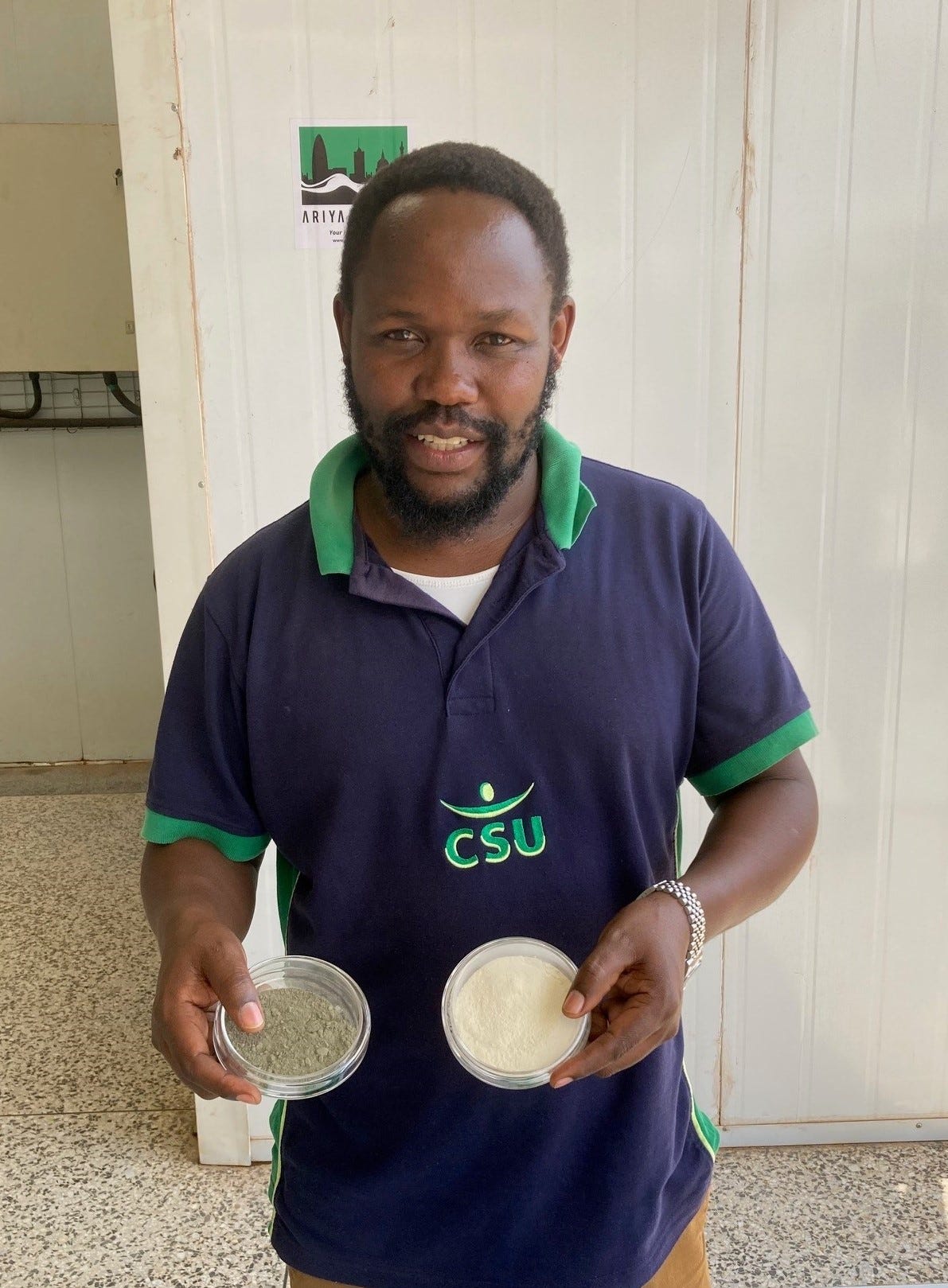Welcome to The Turnstone. Here, I help people understand important issues such as climate change, water quality and conservation. I send my articles out every Sunday - if you’d like them emailed to you directly, you can sign up to my mailing list.
If you’ve ever had a vegetable garden, you’ve surely experienced the frustration of a caterpillar munching its way through your lovingly-tended plants. One day, the plants are lush and green, the next, the leaves are full of holes, or even eaten away completely. Or perhaps you’ve battled a blight, where the leaves develop unsightly spots and begin to wither. Sometimes, whole plants can blacken and die. There’s a feeling of helplessness which comes with seeing all that time and effort come to nothing.
I’ve experienced the frustration and helplessness, but I’ve always had the backup of going to the supermarket. But billions of people worldwide depend directly on the plants that they grow – for some it is their sole source of food, for others, their only income. In Kenya, 75% of the total workforce is involved in agriculture, and most of those either grow crops only or have a mix of crops and livestock. Just over half of Kenya’s farmers describe themselves as subsistence farmers, which means they eat what they grow, with little if any left over for surplus or sale. The arrival of a crop pest or disease can be a matter of life and death.
Although most of Kenya’s farms are small-scale, there is also a growing export sector, with some large-scale and impressive operations. As part of my conference field trip, I visited a farm where they produce cut flowers, mostly roses, for export to Europe. For a cut flower grower, pest and disease problems can quickly destroy the value of a crop by marking the flowers with unsightly damage. It sounds trivial, but it’s not. The farm I visited employs over 1000 people on a permanent basis – the Kenyan climate allows them to produce roses year-round. If the roses are reduced in value, a lot of people have their livelihoods at risk.
It’s a constant battle, as old as agriculture itself. For as long as we have been cultivating plants, there have been pests which find the plants as tasty as we do. Many of them are insects, such as caterpillars, but there are microbes too, such as fungi. It’s a big problem – the UN Food and Agriculture Organisation estimates that plant pests and diseases reduce global crop yields by 20-40% every year.
There’s no simple solution. Every crop has its own set of pests and diseases, and so requires a unique approach to control. But one strategy is to find a compound which will kill the insect or the fungus, and apply that to the crop. It’s a strategy we’ve been using for thousands of years – the first recorded use of chemicals to control pests dates back more than 4000 years, to the ancient Sumerians. More scientific approaches to understanding pests and diseases in the 18th and 19th centuries led to new methods of control. At first, these were mineral compounds, such as copper sulphate and lead arsenate. The development of new chemicals really took off in the 1940s, with the development of powerful products such as DDT (while DDT is for insects, there was a similar revolution, although less well-publicised, in controlling fungal diseases of plants).
Chemical pesticides have their drawbacks, though. In her book Silent Spring, Rachel Carson was the first to bring two of the most significant problems to the public attention – their toxicity in the environment and the tendency for pests to develop resistence to the chemicals. Many of these chemicals are toxic to humans too, and the people most at risk are those who apply the chemicals to the crops, the farmers. In Africa, pesticide poisoning is a serious problem among farmers and their families. A United Nations study estimated that pesticide-related illness was costing billions of dollars per year across Africa. In Kenya, pesticide poisoning is a frequent cause of illness and hospitalisation. Partly, this is because pesticides are not always well-regulated, and compounds which are no longer used in wealthy countries may still be used in developing countries. Part of the problem is that pesticides are often poorly-labelled and farmers may not know what they need to do to keep themselves safe.
But there are alternatives, or at least ways to reduce the amounts of pesticide used while maintaining productivity. After my conference field trip visited the flower farm, we got back on the bus and headed just down the road, to a small facility which produces biological pest control products. I was fascinated to see petri dishes filled with different types of mould which could be used to control crop pests. I was also impressed by the enthusiam of the man in charge of producing these biological pesticides, or biopesticides, Daniel Nene. So I pulled out my business card, introduced myself and asked if he’d be willing to do an interview.
He’s happy to talk, but I have to continue on with my conference field trip, so we meet over Zoom a few days later. The conference is finished and many of the attendees are taking a trip to the Nairobi National Park to look at the wildlife. I’m taking an entirely different kind of safari, where predator and prey are microscopic.
Nene has worked for the company Real IPM since 2006. When he started, Real IPM didn’t produce any biopesticides, so there was a long journey of development. Today, there are a number of different products which help farmers control a range of insects, mites and fungal diseases.
The biopesticides that Nene produces are microbe-based – either fungi or bacteria. He tells me that they have different ways of working, or modes of action, depending on the product. Some are applied as spores, which are a bit like seeds, only for fungi, and go on to cause disease. “When a spore lands on an insect pest, for example, it germinates and grows through the insect’s cuticle [the outer shell of the insect] within 18 hours. There is a lot of multiplication of the fungus in the insect. As the disease develops, the insect will slow down its feeding rate, slow down its reproduction rate and eventually it will die.”
For biopesticides that control plant pathogens [microbes which cause disease]: “some will colonise a plant’s roots and outcompete the pathogen. Others produce chemicals which prevent the pathogen from infecting the plant. Others will actually parasitise the pathogen, that is, they will feed on the pathogen. There are some which trigger immunity in the crop against diseases.”
Making a biopesticide is not like making a chemical product, because biopesticides are living things. The first challenge is to find a microbe which will kill the target pest. “You might start in the forest, you might start with a sample of soil, you might find a diseased insect and use that. If you have a sample of soil, you might put larvae of an insect in the sample and see if they get a disease. When they did, you’ll do a post-mortem. If the larvae have gone soft and rotten that means they are infected with bacteria. If they have gone stiff and hard, it’s usually caused by fungi. If it’s caused by fungi, it will eventually grow out of the insect and you’ll see a colour, maybe white or green, or even purple. Then you have to do identification to figure out exactly what you have.”
Identification is not a straightforward process – it’s a matter of culturing whatever it is which has caused the disease. “You get a beautiful zoo, with all types of colonies,” Nene says. “From all the colonies, you do some preliminary identification, and with experience you can tell if something looks like a beneficial organism. Then you do formal identification by testing the DNA.”
Finding a suitable microbe is only the start. “Once you have material which you want to explore for production, you need to grow it in a controlled environment where you don’t have interference from other species. You introduce your microbe to some sterile material. You don’t want to use something expensive, so you use local material. You can use common foods, like rice, wheat, barley or sorghum, but if you don’t want to use good food, you can use waste material. You have to make sure the material is well-cooked and sterile, and has the right nutrition. Some microbes prefer high carbon and low nitrogen, some the opposite. Once you introduce your microbe, it will take over the material. Then, you separate the microbe from its food and formulate it in different ways so it can be applied to crops. You can apply it in oil, as a powder or dust, as granules or mixed with water.”
Biopesticides have some real advantages over the chemical pesticides which have been widely used over the last century. “They’re environmentally friendly, safe to use and the pests don’t develop resistance to them. And they’re cheap compared to synthetic chemicals.” With so many advantages, I wondered why I hadn’t heard more about them in New Zealand.
A bit of internet searching revealed that there are some products, but not many. The most widely used are based on a type of bacteria known as Bt – this has been used worldwide for decades. There is also a locally-produced biopesticide used to control a native pasture pest known as grass grub. But there’s nothing like the range which Nene and Real IPM make in Kenya. A 2018 paper noted that despite the many advantage, biopesticides weren’t widely used in New Zealand. Part of the reason is the perennial issue of New Zealand’s small market size and there is also a long process for registration. But there is some research underway to develop more products in New Zealand.
Kenya, though, is well ahead. Initially, Real IPM sold biopesticides in large volumes to large-scale farms, like the flower farm I visited. Nene tells me that these elite growers are more conversant with the kind of pest management which uses biopesticides. But they aren’t necessarily the ones who need the products the most. It’s small farmers with limited education who are most at risk from chemical pesticides. So, more recently, Real IPM have been packaging their products in smaller quantities, so that they are affordable for small farmers. There’s a real growth in demand for this type of product, offering hope that harm from chemical pesticides can be reduced in future, while still allowing farmers to protect their crops.
Most articles in The Turnstone are free, but you can support my work and an receive additional material, including more in-depth interviews, with a monthly or annual subscription. Click the button below for options.
If you would like to support The Turnstone with a one-off contribution, click the “Buy me a coffee” button below.






What heartening news and admirable enterprise. Well done, Daniel Nene. Thanks for that, Melanie.
In Cuba they are doing rooftop little Farms, and the result is that some buildings are tottaly self sufficient